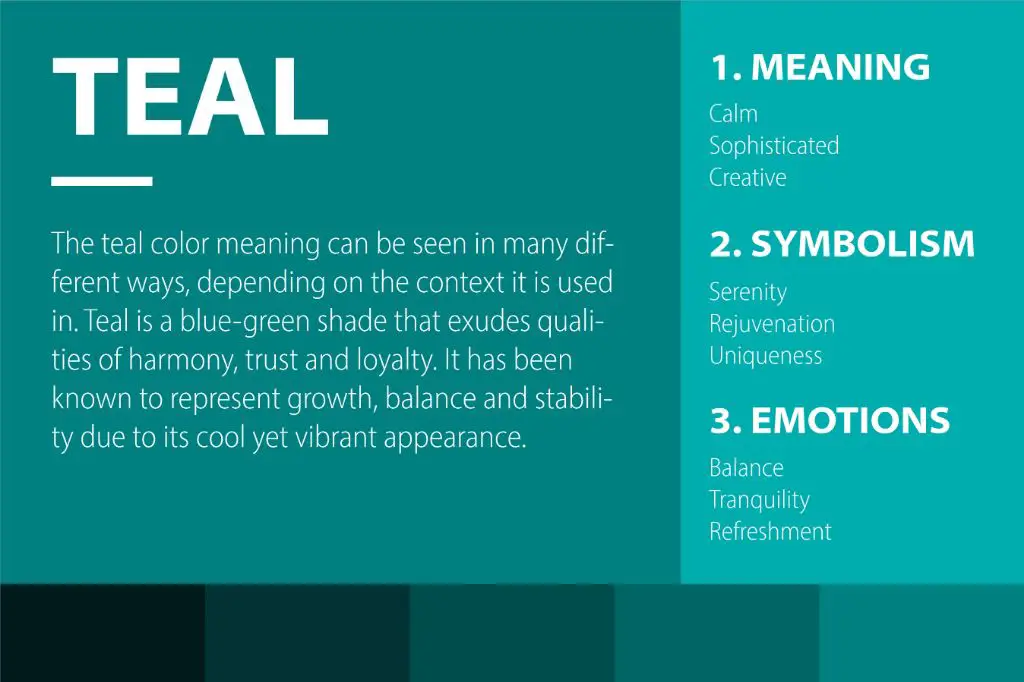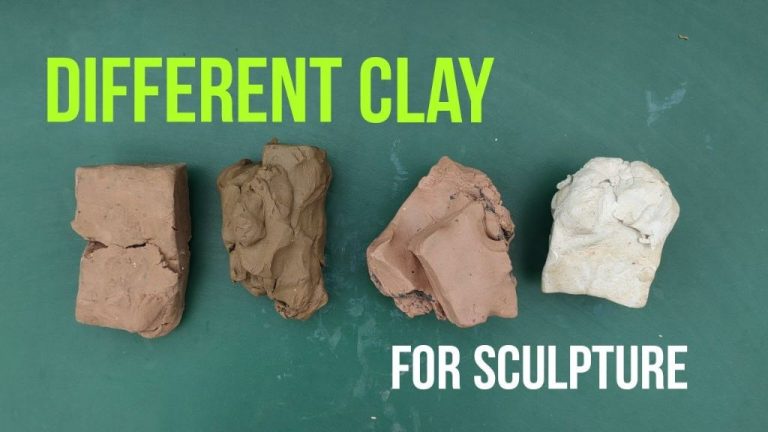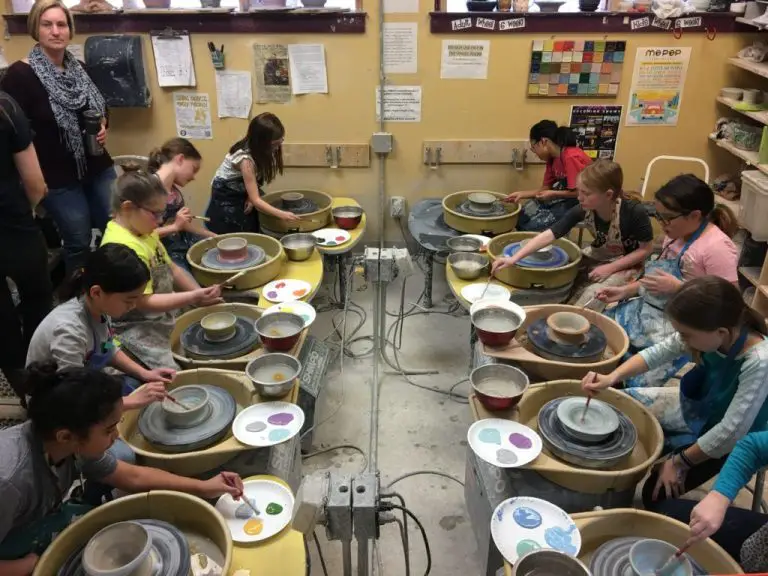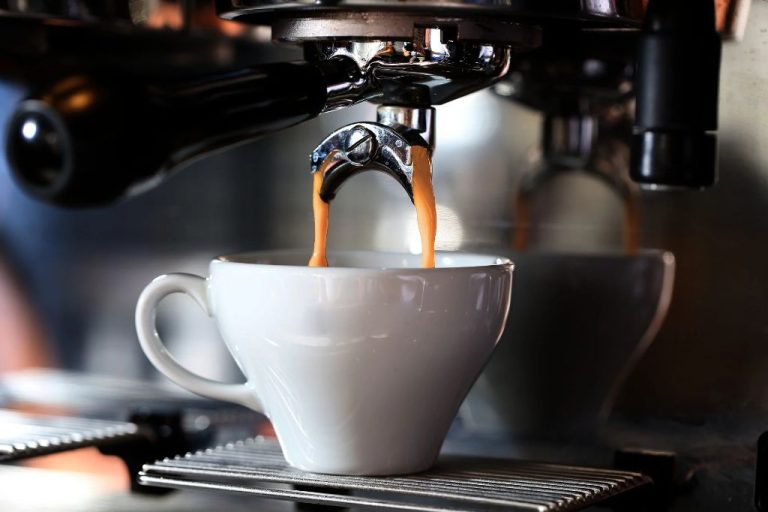Is Deep Teal Green Or Blue?
Defining Deep Teal
The color deep teal has an interesting history behind its name. According to the Wikipedia article on the color teal, the name “teal” first came into use in 1917 and is believed to originate from the Eurasian Teal, a type of freshwater duck that has a stripe of similarly colored greenish-blue feathers on its head.
The term “deep teal” refers to a darker, more saturated version of regular teal. It sits between teal and dark teal on the color wheel. Deep teal has a rich, jewel-like appearance with a balance of green and blue hues. The Hex code for deep teal is #008080, indicating an even mixture of green and blue values.
Characteristics of deep teal include its soothing, elegant, and sophisticated look. It has an earthy quality due to its connection with nature yet also comes across as vibrant, bold, and energetic. Overall, the defining traits of deep teal as a color are its dark bluish-green hue and its association with precious stones, deep waters, and the calming beauty of nature.

Deep Teal’s Hex Code
Hex codes are used in web design, graphic design, and programming to represent colors. A hex code is made up of six characters (0-9 or A-F) that represent values for the red, green, and blue components in RGB color.
Deep Teal has the hex code #005F5F. The six characters break down to represent the RGB values (0, 95, 95). This means Deep Teal is composed of 0% red, 50% green and 50% blue. The large percentage of green is what gives Deep Teal its strong green tone.
Colors like forest green (#228B22) and teal (#008080) have similar hex codes with high values for green but little or no red component. On the other hand, colors like navy (#000080) have high blue values but almost no green or red.
The hex code is a precise way to define the Deep Teal color for digital design and ensures the exact shade is reproduced accurately on screens.
Source: Deep Teal color hex code is #005F5F
Is Deep Teal Closer to Green or Blue?
Deep teal is a unique color that possesses qualities of both green and blue. On the color wheel, teal falls between green and blue, making it difficult to classify it as strictly one or the other. According to this source, teal’s hue falls between 160-180°, landing it directly between green and blue.
In terms of saturation and brightness, deep teal has high saturation like blue but lower brightness like green. This combination produces a rich, jewel-toned color. While deep teal is more saturated than traditional teal, it is not as saturated as a pure primary blue. Similarly, deep teal is darker than a pure green but not as dark as forest green.
So while deep teal possesses qualities of both green and blue, its position on the color wheel and specific hue, saturation, and brightness levels give it a balance between the two. This makes deep teal an intriguing intermediate color that takes on different characteristics depending on lighting and context. Overall, deep teal’s traits likely skew it slightly more toward blue than green.
Uses of Deep Teal
Deep teal is commonly used in various industries and for different purposes due to its soothing and calming properties. According to Canva, teal “represents open communication and clarity of thought.” Some common uses of deep teal include:
In design and marketing, deep teal is often used to promote relaxation, tranquility, and healing. For example, many spas, yoga studios, and retreat centers use teal in their logos and branding. Teal can create a sense of harmony in interior design and is sometimes called “the new neutral” since it works well with multiple color palettes. Brands like Oral-B and Slack use deep teal in their logos to stand out while conveying stability.
In fashion, deep teal is a staple color for spring and summer clothing and accessories. It flatters a wide range of skin tones. Teal gemstones like aquamarine are also popular in jewelry. Runway shows often feature teal tones in dresses, swimsuits, pants, and shoes. Retailers such as J.Crew, Anthropologie, and Free People carry numerous teal clothing items and accessories.
In nature, teal blue-green hues can be found in bodies of water, flowers, plants, and animals around the world. Examples include blue-green algae, peacock feathers, teal jellyfish, Amazonite gemstones, orchids, and more. The vibrant blue-green waters of places like the Maldives and Greece attract tourists.
Deep Teal in Design
Deep teal is a popular color choice in graphic, web, and interior design. This rich, jewel-tone shade evokes a sense of sophistication and drama. According to Italian Bark, “A deeper variant of blue-green teal is a dark cyan. A rich yet balanced hue, which combines the calming properties of blue associated with trust and loyalty, and the energizing aspects of green, associated with growth and harmony.”
In interior design, deep teal is often used to create an exotic, luxurious look. Elle Decor notes that deep teal “embodies depth alongside warmth; cool with calm; it’s cosily enveloping.” Painting an accent wall or pieces of furniture in this dramatic hue adds a touch of the exotic to any room. Deep teal also pairs beautifully with metallics like gold and brass.
In graphic design, deep teal injects a bold, eye-catching color into projects. It stands out against black and white backgrounds. The color evokes a moody, mysterious feeling. Deep teal is commonly used for alternative music, fashion, and photography brands wanting to convey elegance and intensity.
Deep Teal in Fashion
Deep teal is a popular and versatile color in fashion and clothing. Its rich, jewel-toned hue pairs well with many skin tones and can be incorporated in numerous ways.
Deep teal works beautifully in dresses, tops, pants, and accessories. It has an elegant, sophisticated look that stands out. Deep teal flatters lighter skin tones with warm undertones, bringing out green and golden hues. It also complements medium to darker skin tones, adding vibrancy.
Popular ways to wear deep teal include incorporating it as an accent color in prints and patterns. Deep teal makes a striking focal point when used for dresses, blouses, or pants. It can be paired with neutrals like black, white, grey, and tan for a more subdued look. For a bolder fashion statement, deep teal can be combined with other vibrant hues like emerald green, sapphire blue, or amethyst purple.
Accessories like scarves, jewelry, shoes, and handbags pop when done in deep teal. Overall, it’s a lively, dramatic color that conveys luxury and creativity in fashion.
Deep Teal in Nature
Nature provides some of the most stunning examples of the deep teal hue. Here are some interesting natural phenomena that showcase shades of deep teal:
The Green Honeycreeper is a small bird found in forests of Central and South America. These tiny birds have striking plumage in vibrant shades of teal, turquoise, and green.
The Eurasian Teal is a common species of duck found across Europe, Asia, and North Africa. The males have iridescent deep teal heads that shine in the sunlight.
Peacocks are known for their extravagant tail feathers which display a range of iridescent colors. Their coverts and wing feathers often contain gorgeous teal tones.
The Banded Demoiselle is a stunning butterfly found in parts of Asia and the Middle East. These butterflies have velvety wings in a deep teal hue with black bands.
Teal shades are also found underwater, like the vibrant Brazilian Teal sea slug and in minerals such as turquoise and malachite.
Cultural Associations
The color deep teal has various cultural associations and symbolic meanings in different regions and cultures around the world.
In many Asian cultures, deep teal is associated with spirituality, reflection, and calmness. For example, in India, deep teal is known as “peacock green” and connected to qualities like grace and compassion [1]. In China, teal can symbolize wealth and nobility.
Deep teal also has symbolic meaning in many Native American tribes. The Aztecs used deep teal to represent sacrifice and humility. Among the Navajo, the color signifies dawn and happiness. For many Northwestern tribes like the Haida, teal has cultural meaning associated with royalty and crests.
In Western culture, deep teal took on new meaning in the 1960s counterculture and psychedelic art movements. During this time, the vibrant bluish-green hue became associated with spirituality, nature, and exploration [2]. Today, many still feel deep teal evokes these qualities and can promote inner peace.
Across regions and cultures, deep teal often represents balance, wisdom, and intuitive energy. It occupies an intriguing space between green and blue that resonates with many symbolic meanings.
[1] https://creativebooster.net/blogs/colors/teal-color-meaning
[2] https://www.appypie.com/blog/teal-color
Scientific Properties
Deep teal’s unique color comes from a specific combination of wavelengths of light. The wavelength of light determines its color. Teal shades like deep teal result when the wavelengths for blue and green light combine in the right proportions.
Specifically, deep teal has a dominant wavelength of approximately 491 nanometers, placing it between blue and green on the visible spectrum. This wavelength stimulates both the blue and green color receptors in our eyes, creating the aqua or teal appearance.
At the optical level, teal wavelengths have some interesting effects. According to studies, blue-green hues like deep teal can have a relaxing yet mentally stimulating effect. Researchers believe this is because the wavelengths trigger our brains to release more dopamine, the “feel good” neurotransmitter.[1] This helps create a balanced and rejuvenating sensation.
Additionally, the balance of cool blue and lively green wavelengths makes teal shades naturally vibrant and energizing to look at. This striking color interaction may explain why deep teal is widely considered an uplifting, refreshing hue.
[1] https://www.colorpsychology.org/teal/
Summary
In summary, deep teal seems to fall closer to green than blue on the color spectrum. While deep teal is a mix of blue and green pigments, the dominance of its green undertones leads it to be categorized with other shades of green more often than shades of blue. This distinction matters most when coordinating colors for design projects, fashion, or decor. Deep teal will pair better with analogous green hues rather than analogous blues. However, deep teal is still versatile enough to work well alongside a variety of colors.




